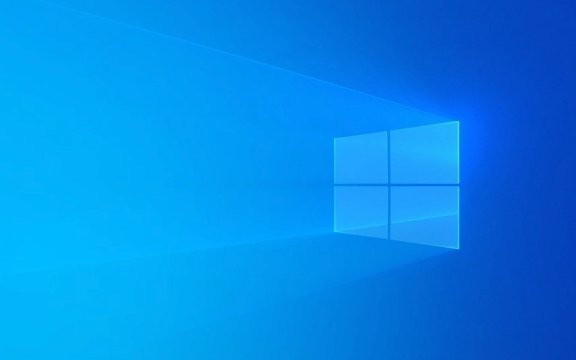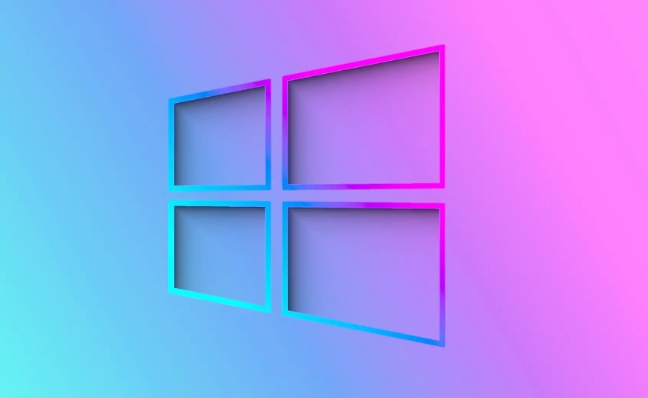How to change mouse sensitivity in Windows
Jul 31, 2025 am 07:40 AMOpen Settings with Windows I, go to Devices > Mouse, click "Additional mouse options," then under the Pointer Options tab, adjust the slider in the Motion section to change sensitivity—slower for precision, faster for speed—and click Apply > OK. 2. Optionally, uncheck "Enhance pointer precision" for consistent cursor movement. 3. For gaming or high-DPI mice, use manufacturer software like Logitech G Hub or Razer Synapse to adjust DPI settings for hardware-level control. 4. Advanced users can fine-tune sensitivity via the Registry by modifying the MouseSensitivity value under HKEY_CURRENT_USER\Control Panel\Mouse, setting it between 1 and 20, then restarting. 5. Touchpad users should adjust sensitivity separately in Touchpad settings. For most users, adjusting the pointer speed and disabling pointer precision enhancement is sufficient, and settings can be customized per mouse type, making it easy to optimize cursor behavior with just a few clicks.

Changing mouse sensitivity in Windows is straightforward and can make a big difference in how your cursor moves and responds. Whether you're using a desktop, laptop, or gaming mouse, adjusting the sensitivity helps tailor the experience to your needs—whether for precision work or faster navigation.

Here’s how to adjust mouse sensitivity in Windows 10 and Windows 11:
1. Adjust Pointer Speed in Mouse Settings
This is the most common way to change how fast your mouse moves on screen.

Steps:
-
Press
Windows Ito open Settings.
Go to Devices > Mouse (in Windows 11) or Bluetooth & devices > Mouse (in Windows 11 newer versions).
-
Click on Additional mouse options (on the right side, under "Related settings").
This opens the classic Mouse Properties window.
In the Pointer Options tab, look for the Motion section.
-
Use the slider under Select a pointer speed to adjust sensitivity:
- Slow (left): Cursor moves slower, more precise.
- Fast (right): Cursor moves faster, less control.
Click Apply > OK to save.
? Tip: Uncheck "Enhance pointer precision" if you want consistent, non-accelerated movement. This setting makes the cursor speed depend on how fast you move the mouse, which some users find unpredictable.
2. Use Control Panel (Works on All Windows Versions)
If you prefer the older interface or are on Windows 10:
- Open the Control Panel (you can search for it in the Start menu).
- Set View by to "Small icons" or "Large icons".
- Click on Mouse.
- Go to the Pointer Options tab and adjust the slider as described above.
3. Change Sensitivity for Gaming or High-Precision Mice
If you're using a gaming or high-DPI mouse:
- The built-in Windows settings may not be enough.
- Use the manufacturer’s software such as:
- Logitech G Hub
- Razer Synapse
- SteelSeries GG
- Microsoft Mouse and Keyboard Center
These apps let you adjust DPI (dots per inch) directly, which controls hardware-level sensitivity—more precise than just changing pointer speed.
? Example: A 1600 DPI setting means the cursor moves 1600 pixels when you move the mouse one inch. Higher DPI = faster movement.
4. Fine-Tune with Registry (Advanced Users)
For advanced users, Windows sensitivity can be fine-tuned beyond the 1–11 scale via the Registry, though this is rarely needed.
?? Warning: Editing the registry can cause system issues if done incorrectly. Back it up first.
- Press
Win R, typeregedit, and press Enter. - Navigate to:
HKEY_CURRENT_USER\Control Panel\Mouse
- Look for the value MouseSensitivity (pointer speed).
- Change it to a number between 1 and 20 (default is usually 10).
- Restart or log out/in for changes to apply.
Final Notes
- For most users, adjusting the pointer speed slider and disabling Enhance pointer precision is enough.
- If you use multiple mice (e.g., work vs. gaming), consider saving different settings or using mouse-specific software.
- Touchpad users: Look under Touchpad settings in Windows for separate sensitivity controls.
Basically, it’s not complicated—just a few clicks to make your mouse feel just right.
The above is the detailed content of How to change mouse sensitivity in Windows. For more information, please follow other related articles on the PHP Chinese website!

Hot AI Tools

Undress AI Tool
Undress images for free

Undresser.AI Undress
AI-powered app for creating realistic nude photos

AI Clothes Remover
Online AI tool for removing clothes from photos.

Clothoff.io
AI clothes remover

Video Face Swap
Swap faces in any video effortlessly with our completely free AI face swap tool!

Hot Article

Hot Tools

Notepad++7.3.1
Easy-to-use and free code editor

SublimeText3 Chinese version
Chinese version, very easy to use

Zend Studio 13.0.1
Powerful PHP integrated development environment

Dreamweaver CS6
Visual web development tools

SublimeText3 Mac version
God-level code editing software (SublimeText3)
 How to change the system display language for all users in Windows
Jul 31, 2025 am 08:18 AM
How to change the system display language for all users in Windows
Jul 31, 2025 am 08:18 AM
InstallthedesiredlanguagepackviaSettings→Time&Language→Language®ion,ensuring"SetasmyWindowsdisplaylanguage"isselected.2.Changethesystemdisplaylanguageinthesamemenuandrestart.3.OpenControlPanel→Region→Administrativetab,click"
 How to reset the Microsoft Store in Windows
Jul 31, 2025 am 08:23 AM
How to reset the Microsoft Store in Windows
Jul 31, 2025 am 08:23 AM
ResettheMicrosoftStoreviaSettingsbygoingtoApps>Installedapps,selectingMicrosoftStore,clickingAdvancedoptions,thenRepairandResetifneeded.2.Ifthatfails,re-registertheStoreusingPowerShellasadminwiththecommand:Get-AppXPackage-NameMicrosoft.WindowsStor
 How to install Windows on a Mac without Boot Camp
Jul 31, 2025 am 11:58 AM
How to install Windows on a Mac without Boot Camp
Jul 31, 2025 am 11:58 AM
Without BootCamp, installing Windows on Mac is feasible and works for different chips and needs. 1. First check compatibility: The M1/M2 chip Mac cannot use BootCamp, it is recommended to use virtualization tools; the Intel chip Mac can manually create a boot USB disk and install it in partition. 2. Recommended to use virtual machines (VMs) for M1 and above chip users: Windows ISO files, virtualization software (such as ParallelsDesktop or UTM), at least 64GB of free space, and reasonably allocate resources. 3. IntelMac users can manually install it by booting the USB drive: USB drive, WindowsISO, DiskU is required
 How to reset the TCP/IP stack in Windows
Aug 02, 2025 pm 01:25 PM
How to reset the TCP/IP stack in Windows
Aug 02, 2025 pm 01:25 PM
ToresolvenetworkconnectivityissuesinWindows,resettheTCP/IPstackbyfirstopeningCommandPromptasAdministrator,thenrunningthecommandnetshintipreset,andfinallyrestartingyourcomputertoapplychanges;ifissuespersist,optionallyrunnetshwinsockresetandrebootagain
 How to install Windows on a Mac
Jul 31, 2025 am 10:07 AM
How to install Windows on a Mac
Jul 31, 2025 am 10:07 AM
ForIntel-basedMacs,useBootCampAssistanttocreateadual-bootsystemwithWindowsbypreparingaUSBdrive,downloadingaWindowsISO,partitioningthedisk,andinstallingWindowsalongsidemacOSwithsupportdrivers.2.ForAppleSiliconMacs(M1/M2/M3),usevirtualizationsoftwareli
 Step-by-step guide to installing Windows from an ISO file
Aug 01, 2025 am 01:10 AM
Step-by-step guide to installing Windows from an ISO file
Aug 01, 2025 am 01:10 AM
DownloadtheWindowsISOfromMicrosoft’sofficialsite.2.CreateabootableUSBusingMediaCreationToolorRufuswithaUSBdriveofatleast8GB.3.BootfromtheUSBbyaccessingthebootmenuoradjustingBIOS/UEFIsettings.4.InstallWindowsbyselectingcustominstallation,choosingtheco
 A guide to custom Windows installation options
Aug 01, 2025 am 04:48 AM
A guide to custom Windows installation options
Aug 01, 2025 am 04:48 AM
Choose"Custom:InstallWindowsonly(advanced)"forfullcontrol,asitallowsacleaninstallthatremovesoldissuesandoptimizesperformance.2.Duringsetup,managepartitionsbydeletingoldones(afterbackingupdata),creatingnewpartitions,formatting(usingNTFS),ors
 How to manage AppLocker policies in Windows
Aug 02, 2025 am 12:13 AM
How to manage AppLocker policies in Windows
Aug 02, 2025 am 12:13 AM
EnableAppLockerviaGroupPolicybyopeninggpedit.msc,navigatingtoApplicationControlPolicies,creatingdefaultrules,andconfiguringruletypes;2.Createcustomrulesusingpublisher,path,orhashconditions,preferringpublisherrulesforsecurityandflexibility;3.Testrules







